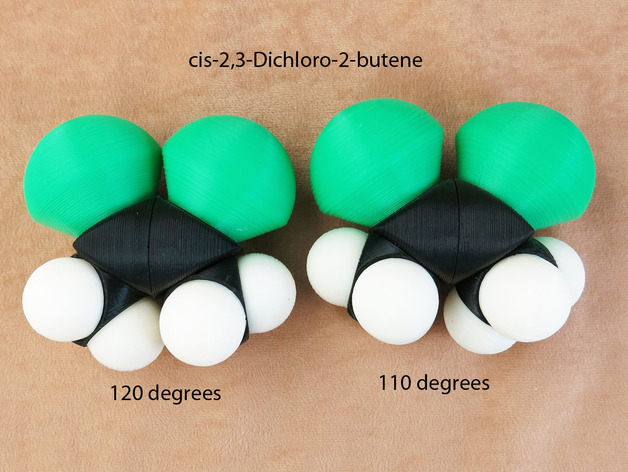
Space-filling molecular models: Carbon expansion set
thingiverse
Carbon atoms generally form four bonds to other atoms, resulting in a tetrahedral shape with an atom attached to each face when each bond is single. If there's a double bond, the atoms usually occupy the same plane and are 120 degrees apart from one another. With a triple bond, the atoms align straight across. Here are carbon atoms for multiply bonded atoms: I created CarbonDB2 for two carbon atoms connected by a double bond. When you have a double bond with bulky side groups on the same side as the bond (the "cis" side in chemspeak), the angle between the singly bonded atoms may relax, typically to around 110 degrees. Use CarbonDBR then. If you have a carbon double-bonded to any other atom (usually oxygen or nitrogen) use CarbonDB3. It's similar to CarbonDB2 but with slightly relaxed edges for better looks. You can choose either one. For most atoms provided, you can rotate them around the bond; however, this isn't possible with double-bonded ones as they're locked in place like real atoms. The rectangular socket represents a slightly shorter bond distance than others and is used for double bonds. CarbonTB3 is designed for triple-bonded carbon atoms. Although theoretically, these can't be rotated either, you can only bond them to another carbon or nitrogen resulting in symmetry; no one will notice it's not locked so I didn't bother. What looks like a triple bond but isn't is actually a cumulative double bond - two groups end-to-end locked at right angles. Use CarbonCDB1 for this. "I'll never need that" you might say, but carbon dioxide uses this very carbon atom and it's symmetrical and boring. Get out more, my wife says the same thing. Space-filling models rely on two measurements: covalent radius (distance between atoms) and Van der Waals radius (diameter of the atom). Covalent radii can be accurately calculated while Van der Waals radii are harder to determine. There are several values for carbon's Van der Waals radius; I use 1.5 Angstroms which is slightly small (some use 1.7); it looks better this way. Perhaps aesthetics shouldn't be the first consideration but it's worth thinking about too. As a bonus, this set includes double-bonded oxygen atoms. See the starter set (http://www.thingiverse.com/thing:1720048), halogen expansion set (http://www.thingiverse.com/thing:1730099), and sulfur and phosphorous expansion set (http://thingaverse.com/thing:2350618) for more useful elements. Print Settings Printer Da Vinci 1A Rafts No Supports Doesn't Matter Resolution 0.2 mm Infill 10% Notes Three perimeters work well
With this file you will be able to print Space-filling molecular models: Carbon expansion set with your 3D printer. Click on the button and save the file on your computer to work, edit or customize your design. You can also find more 3D designs for printers on Space-filling molecular models: Carbon expansion set.
